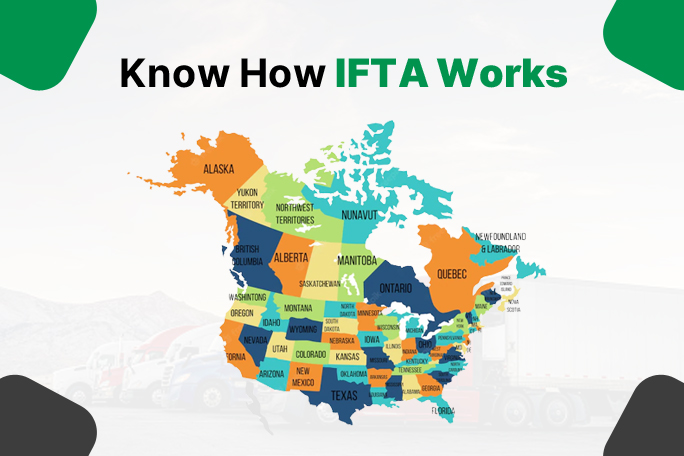-
ALL-IN-ONE TRUCKING PLATFORM

Find out how our truck management solution can ease your day to day life.

IFTA, aka The International Fuel Tax Agreement, is an agreement that was made for truckers who often cross state lines on their journeys. It streamlines accounting and fuel tax payments and relieves trucking companies of some administrative burdens.
Are you someone who wants to have a piece of in-depth knowledge about the working of IFTA? You’re at the right place. In this article, we’ll give you more information on IFTA and the possible effects it can have on your fleet. So, what are you waiting for? Let’s get started right away.
IFTA makes it easier for truckers and trucking firms to pay fuel taxes. In the past, collecting fuel taxes required trucks to stop at a port of entry to purchase a permit, which was time-consuming.
By simplifying paperwork and lowering compliance requirements, the current IFTA reporting system makes it easier for trucking companies (including owner-operators) that operate across IFTA nations to report fuel tax.
However, you should remember that IFTA is not a separate tax. The purpose of IFTA is to shift taxes to the states where gasoline is actually consumed rather than to the areas where it is bought. This implies that you must pay the fuel tax in the states you travel through regardless of where you purchase the fuel.
Currently, the lower 48 States of the United States and the provinces of Canada have signed the International Fuel Tax Agreement. No IFTA jurisdiction includes Alaska, Hawaii, Washington, D.C., or any other territories.
Any motor vehicle that meets the following requirements must have IFTA:
After you’ve established the fact that your fleet requires an IFTA, here’s what you need to do to get one.
If a vehicle is registered in more than one state, its owner must get in touch with that state to ask if it can be combined under a single license. The IFTA car decal will be provided by the home state. The home state is where the operator keeps the vehicle’s operating records or has access to them.
The Federal Highway Administration maintains a list of state Department of Transportation websites that can be used for registration. Further, at the end of each fiscal quarter, the licensee generates a fuel tax report that includes the number of miles driven in each participating jurisdiction as well as the number of gallons of fuel bought there.
The vehicle mileage record, distance records, fuel records, and tax-paid retail fuel purchase receipts are examples of supporting documentation. When reporting IFTA claims, you must provide all pertinent information, such as gap miles and fuel receipts.
One major benefit of IFTA is that you can save big time on fuel costs. You get to deduct the state fuel tax from the retail price you pay for the fuel to get the net price when deciding whether to purchase it in one state or another. This is due to the fact that under the current IFTA policy, taxes are based on the states in which gasoline is used rather than the state in which it is purchased. Fuel taxes are therefore irrelevant because they are already being paid. This means that rather than paying the retail price, you have the liberty to buy fuel in the state where the net price will be the lowest.
You can calculate IFTA fuel tax in five easy steps:
Fleet management and drivers must collaborate on a single platform to ensure the precise recording of the quantity of fuel used in various countries. Fleets must therefore manage their drivers’ records of duty status very well.
Additionally, drivers are responsible for recording every time they cross state boundaries on their odometers. To eliminate human mistakes, you can use fleet management or route planning software like TruckSmartz to digitally document the miles your drivers travel in each jurisdiction.
The gallons of fuel purchased in each jurisdiction is the next piece of data you want for IFTA fuel tax reports.
Remember that carriers must save the original receipts or invoices from demonstrating that fuel tax was paid. These records must include:
The next step is to calculate the fuel mileage of your vehicles for each jurisdiction after adding up the miles driven and the fuel purchased. You can use the formula below to get the overall fuel mileage of your fleet:
Overall fuel mileage = total miles traveled / total gallons.
For instance, if you bought 8,000 gallons of petrol altogether and drove 40,000 miles, your overall fuel mileage would be:
5 miles per gallon (40,000/8,000).
The primary factor required to determine the amount of fuel tax your fleet owes each country is the volume of fuel purchased per jurisdiction. This depends on the rates that are in effect for the current IFTA quarter.
On the official website of the International Fuel Tax Association, you can see the full chart of fuel tax rates for each fuel type and country. Please be aware that these prices could fluctuate up until the subsequent due date.
Finally, you can figure out how much tax you actually owe each state by using the formula given below.
Fuel tax due to State X = fuel tax needed by State X – fuel tax paid in State X
Fuel receipts or fuel withdrawal slips can be used to calculate the fuel tax paid at the time of purchase.
We hope we have aided you in understanding the working of IFTA. The process might seem overwhelming; thus, to help you out, we have designed an automated tool called TruckSmartz that can ease the process for you.
You can automate IFTA reports with TruckSmartz, which will also help you focus your efforts. Every driver of a vehicle in your fleet, no matter how big or little can immediately link location and calculations for fuel purchase information. The IFTA Service Providers can then get this information from your team via File Transfer Protocol (FTP) transfer. The likelihood of human error on operator reports may be significantly reduced by this fully automated integration, which also makes reporting on fuel efficiency simpler and more accurate.
Spend more time working on growing your business when TruckSmartz takes the hassle of managing the mundane tasks off your shoulders.
Show Me How